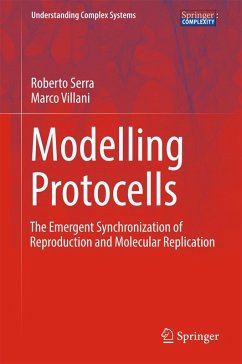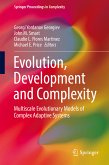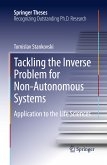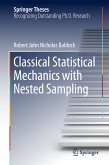Roberto Serra, Marco Villani
Modelling Protocells (eBook, PDF)
The Emergent Synchronization of Reproduction and Molecular Replication
64,95 €
64,95 €
inkl. MwSt.
Sofort per Download lieferbar

32 °P sammeln
64,95 €
Als Download kaufen

64,95 €
inkl. MwSt.
Sofort per Download lieferbar

32 °P sammeln
Jetzt verschenken
Alle Infos zum eBook verschenken
64,95 €
inkl. MwSt.
Sofort per Download lieferbar
Alle Infos zum eBook verschenken

32 °P sammeln
Roberto Serra, Marco Villani
Modelling Protocells (eBook, PDF)
The Emergent Synchronization of Reproduction and Molecular Replication
- Format: PDF
- Merkliste
- Auf die Merkliste
- Bewerten Bewerten
- Teilen
- Produkt teilen
- Produkterinnerung
- Produkterinnerung

Bitte loggen Sie sich zunächst in Ihr Kundenkonto ein oder registrieren Sie sich bei
bücher.de, um das eBook-Abo tolino select nutzen zu können.
Hier können Sie sich einloggen
Hier können Sie sich einloggen
Sie sind bereits eingeloggt. Klicken Sie auf 2. tolino select Abo, um fortzufahren.

Bitte loggen Sie sich zunächst in Ihr Kundenkonto ein oder registrieren Sie sich bei bücher.de, um das eBook-Abo tolino select nutzen zu können.
Provides a unitary approach to protocell models Includes a brief discussion on the role of quantum coherent states in the origin of life Written by the Chairman of the Science Board of the European Centre for Living Technology
- Geräte: PC
- ohne Kopierschutz
- eBook Hilfe
- Größe: 4.48MB
Andere Kunden interessierten sich auch für
![The Essential Tension (eBook, PDF) The Essential Tension (eBook, PDF)]() Sonya BaharThe Essential Tension (eBook, PDF)46,95 €
Sonya BaharThe Essential Tension (eBook, PDF)46,95 €![Evolution, Development and Complexity (eBook, PDF) Evolution, Development and Complexity (eBook, PDF)]() Evolution, Development and Complexity (eBook, PDF)191,95 €
Evolution, Development and Complexity (eBook, PDF)191,95 €![Principles of Evolution (eBook, PDF) Principles of Evolution (eBook, PDF)]() Principles of Evolution (eBook, PDF)52,95 €
Principles of Evolution (eBook, PDF)52,95 €![Tackling the Inverse Problem for Non-Autonomous Systems (eBook, PDF) Tackling the Inverse Problem for Non-Autonomous Systems (eBook, PDF)]() Tomislav StankovskiTackling the Inverse Problem for Non-Autonomous Systems (eBook, PDF)72,95 €
Tomislav StankovskiTackling the Inverse Problem for Non-Autonomous Systems (eBook, PDF)72,95 €![High-Dimensional Chaotic and Attractor Systems (eBook, PDF) High-Dimensional Chaotic and Attractor Systems (eBook, PDF)]() Vladimir G. IvancevicHigh-Dimensional Chaotic and Attractor Systems (eBook, PDF)112,95 €
Vladimir G. IvancevicHigh-Dimensional Chaotic and Attractor Systems (eBook, PDF)112,95 €![Classical Statistical Mechanics with Nested Sampling (eBook, PDF) Classical Statistical Mechanics with Nested Sampling (eBook, PDF)]() Robert John Nicholas BaldockClassical Statistical Mechanics with Nested Sampling (eBook, PDF)72,95 €
Robert John Nicholas BaldockClassical Statistical Mechanics with Nested Sampling (eBook, PDF)72,95 €![Chaos (eBook, PDF) Chaos (eBook, PDF)]() Chaos (eBook, PDF)40,95 €
Chaos (eBook, PDF)40,95 €-
-
-
Provides a unitary approach to protocell models
Includes a brief discussion on the role of quantum coherent states in the origin of life
Written by the Chairman of the Science Board of the European Centre for Living Technology
Dieser Download kann aus rechtlichen Gründen nur mit Rechnungsadresse in A, B, BG, CY, CZ, D, DK, EW, E, FIN, F, GR, HR, H, IRL, I, LT, L, LR, M, NL, PL, P, R, S, SLO, SK ausgeliefert werden.
Produktdetails
- Produktdetails
- Verlag: Springer Netherlands
- Seitenzahl: 182
- Erscheinungstermin: 24. Juli 2017
- Englisch
- ISBN-13: 9789402411607
- Artikelnr.: 53064215
- Verlag: Springer Netherlands
- Seitenzahl: 182
- Erscheinungstermin: 24. Juli 2017
- Englisch
- ISBN-13: 9789402411607
- Artikelnr.: 53064215
- Herstellerkennzeichnung Die Herstellerinformationen sind derzeit nicht verfügbar.
Roberto Serra is full professor of Complex Systems at the University of Modena and Reggio Emilia. He has previously been the Head of the Environmental Research Centre of the Montedison industrial group, the President of the Italian Association for Artificial Intelligence AI*IA and the Chairman of the Science Board of the European Centre for Living Technology. His main research interests, besides protocells, concern the dynamical modelling of Complex Systems, with applications to gene regulatory networks and cell differentiation, the analysis of their organization and the dynamical systems approach to Artificial Intelligence. He is the author or editor of eight books and of about 160 papers in international journals and conference proceedings with peer review.
Marco Villani is associate professor of Computer Science at the University of Modena and Reggio Emilia and a fellow of the European Centre for Living Technology. His main research interests, besides protocells, concern the dynamical modelling of Complex Systems, with applications to gene regulatory networks and cell differentiation, the analysis of their organization and the simulation of social systems. He is the editor of three books and of about 100 papers in international journals and conference proceedings with peer review.
Foreword.- Introduction.- About protocells.- Why modelling protocells.- Collective self-replication.- Self-replication in a vesicle.- Self-replication in a reproducing protocell.- Generic properties of dynamical models of protocells.- Introduction. -Generic properties of biological systems: data.- Generic properties of biological systems: concepts.- What shall we model.- Dynamical models of protocells and synchronization.- Simplified surface-reaction models of protocells.- Synchronization in surface reaction models.- Several linearly interacting replicators.- Several interacting replicators with nonlinear interactions.- Internal reaction models.- Models of self-replication.- Introduction.- Autocatalytic sets.- The properties of some replication models.- Products and substrates.- Reflexive autocatalytic food-generated (raf) sets.- A stochastic model of growing and dividing protocells.- Semipermeable protocells.- The role of active membranes.- The effects of passive membranes.- Coupled dynamics of rafs and protocells.- Maintaining novelties.-A comment on evolvable populations of protocells.- Conclusions, open questions and perspectives.- Introduction.- The hypothesis of spontaneous fission and synchronization.- The formation of self-sustaining autocatalytic cycles.- The role of membranes.- A virtual laboratory.
Foreword.- Introduction.- About protocells.- Why modelling protocells.- Collective self-replication.- Self-replication in a vesicle.- Self-replication in a reproducing protocell.- Generic properties of dynamical models of protocells.- Introduction. -Generic properties of biological systems: data.- Generic properties of biological systems: concepts.- What shall we model.- Dynamical models of protocells and synchronization.- Simplified surface-reaction models of protocells.- Synchronization in surface reaction models.- Several linearly interacting replicators.- Several interacting replicators with nonlinear interactions.- Internal reaction models.- Models of self-replication.- Introduction.- Autocatalytic sets.- The properties of some replication models.- Products and substrates.- Reflexive autocatalytic food-generated (raf) sets.- A stochastic model of growing and dividing protocells.- Semipermeable protocells.- The role of active membranes.- The effects of passive membranes.- Coupled dynamics of rafs and protocells.- Maintaining novelties.-A comment on evolvable populations of protocells.- Conclusions, open questions and perspectives.- Introduction.- The hypothesis of spontaneous fission and synchronization.- The formation of self-sustaining autocatalytic cycles.- The role of membranes.- A virtual laboratory.







